The INOVMineral Project’s Contribution to Mineral Exploration—A WebGIS Integration and Visualization of Spectral and Geophysical Properties of the Aldeia LCT Pegmatite Spodumene Deposit
Abstract
1. Introduction
1.1. Study Area
2. Materials and Methods
2.1. Sample Collection
2.2. Data Acquisition and Data Processing
2.2.1. Unmanned Aerial Vehicle (UAV) Surveys
2.2.2. Geophysical Surveys
2.2.3. Spectral Data Acquisition and Processing
2.3. Integration of Spectral Data through Satellite Image Processing
3. Data Integration and Visualization in a WebGIS Platform
3.1. WebGIS
3.1.1. Digital Elevation Model (DEM)
3.1.2. Radiometry Data
3.1.3. Spectral Data
4. Results and Discussion
4.1. UAV LiDAR
4.2. Radiometry
4.3. Spectral Library
4.3.1. Spectral Analysis
4.3.2. Comparison of the Laboratory Spectra and Satellite Imagery
4.3.3. Principal Components Analysis (PCA)
4.4. WebGIS
5. Conclusions
- i.
- The obtention of high spatial resolution elevation data, such as a LiDAR-derived DEM, can be very helpful in understanding pegmatite outcrop distribution and is a fundamental base layer to overlay other kinds of data.
- ii.
- The acquisition of radiometric data through geophysical techniques can be a good approach to discriminate pegmatites and their host rocks, if their radiometric differences occur in a magnitude sufficient to be detected. Future studies must evaluate the penetration depth of this technique to detect buried pegmatites. Other geophysical techniques should be applied.
- iii.
- A successful methodology was proposed to structure the reflectance spectroscopy data into a spectral library, with freely available public access data that can even serve as a source of validation in new scientific studies.
- iv.
- The spectral library proposed in this study proved to be of high added value for space-based exploration. The superposition of the Landsat 9 bands over the selected reference spectra of distinct aplite–pegmatite samples allowed the selection of the best satellite bands for further testing.
- v.
- The performance of Landsat 9 and Landsat 8 data were compared. At the same time, the potential use of the spectral library and the success of the combined approach (comparison with satellite data spectral resolution) were positively evaluated with the correct identification of known LCT pegmatite targets.
- vi.
- The development of a user-friendly webGIS platform allowed data integration and visualization, as well as data sharing and dissemination to aid potential users in similar approaches.
Author Contributions
Funding
Data Availability Statement
Acknowledgments
Conflicts of Interest
References
- Gourcerol, B.; Gloaguen, E.; Melleton, J.; Tuduri, J.; Galiegue, X. Re-assessing the European lithium resource potential—A review of hard-rock resources and metallogeny. Ore Geol. Rev. 2019, 109, 494–519. [Google Scholar] [CrossRef]
- Blengini, G.A.; Latunussa, C.E.L.; Eynard, U.; Torres de Matos, C.; Wittmer, D.; Georgitzikis, K.; Pavel, C.; Carrara, S.; Mancini, L.; Unguru, M.; et al. Study on the EU’s List of Critical Raw Materials Final Report; European Commission: Brussels, Belgium, 2020. [Google Scholar]
- Müller, A.; Reimer, W.; Wall, F.; Williamson, B.; Menuge, J.; Brönner, M.; Haase, C.; Brauch, K.; Pohl, C.; Lima, A.; et al. GREENPEG—Exploration for pegmatite minerals to feed the energy transition: First steps towards the Green Stone Age. Geol. Soc. Lond. Spec. Publ. 2022, 526, SP526-2021-189. [Google Scholar] [CrossRef]
- Steiner, B.M. Tools and Workflows for Grassroots Li–Cs–Ta (LCT) Pegmatite Exploration. Minerals 2019, 9, 499. [Google Scholar] [CrossRef]
- Galeschuk, C.R.; Vanstone, P.J. Exploration techniques for rare-element pegmatite in the Bird River greenstone belt, southeastern Manitoba. In Proceedings of the Exploration 07: Fifth Decennial International Conference on Mineral Exploration, Toronto, ON, Canada, 9–12 September 2007; pp. 823–839. [Google Scholar]
- Kaeter, D.; Menuge, J.F.; Harrop, J. Stream sediment geochemistry for regional prospectivity analysis: Tin, cesium, tantalum and tungsten anomalies in Leinster, Southeast Ireland. In Proceedings of the 15th SGA Biennial Meeting, Glasgow, UK, 27–30 August 2019; pp. 1228–1231. [Google Scholar]
- Fyzollahhi, N.; Torshizian, H.; Afzal, P.; Jafari, M.R. Determination of lithium prospects using fractal modeling and staged factor analysis in Torud region, NE Iran. J. Geochem. Explor. 2018, 189, 2–10. [Google Scholar] [CrossRef]
- Saadati, H.; Afzal, P.; Torshizian, H.; Solgi, A. Geochemical exploration for lithium in NE Iran using the geochemical mapping prospectivity index, staged factor analysis, and a fractal model. Geochem. Explor. Environ. Anal. 2020, 20, 461–472. [Google Scholar] [CrossRef]
- Cardoso-Fernandes, J.; Lima, J.; Lima, A.; Roda-Robles, E.; Köhler, M.; Schaefer, S.; Barth, A.; Knobloch, A.; Gonçalves, M.A.; Gonçalves, F.; et al. Stream sediment analysis for Lithium (Li) exploration in the Douro region (Portugal): A comparative study of the spatial interpolation and catchment basin approaches. J. Geochem. Explor. 2022, 236, 106978. [Google Scholar] [CrossRef]
- Errandonea-Martin, J.; Garate-Olave, I.; Roda-Robles, E.; Cardoso-Fernandes, J.; Lima, A.; Ribeiro, M.d.A.; Teodoro, A.C. Metasomatic effect of Li-bearing aplite-pegmatites on psammitic and pelitic metasediments: Geochemical constraints on critical raw material exploration at the Fregeneda—Almendra Pegmatite Field (Spain and Portugal). Ore Geol. Rev. 2022, 150, 105155. [Google Scholar] [CrossRef]
- Keyser, W.; Müller, A.; Knoll, T.; Menuge, J.F.; Steiner, R.; Berndt, J.; Hart, E.; Fegan, T.; Harrop, J. Quartz chemistry of lithium pegmatites and its petrogenetic and economic implications: Examples from Wolfsberg (Austria) and Moylisha (Ireland). Chem. Geol. 2023, 630, 121507. [Google Scholar] [CrossRef]
- Trueman, D.L. Exploring for a Tanco type pegmatite. In Proceedings of the International Workshop on the Geology of Rare Metals, Victoria, BC, Canada, 9–10 November 2010. [Google Scholar]
- Thomas, M.D.; Ford, K.L.; Keating, P. Review paper: Exploration geophysics for intrusion-hosted rare metals. Geophys. Prospect. 2016, 64, 1275–1304. [Google Scholar] [CrossRef]
- Gao, Y.; Bagas, L.; Li, K.; Jin, M.; Liu, Y.; Teng, J. Newly Discovered Triassic Lithium Deposits in the Dahongliutan Area, NorthWest China: A Case Study for the Detection of Lithium-Bearing Pegmatite Deposits in Rugged Terrains Using Remote-Sensing Data and Images. Front. Earth Sci. 2020, 8, 591966. [Google Scholar] [CrossRef]
- Santos, D.; Cardoso-Fernandes, J.; Lima, A.; Müller, A.; Brönner, M.; Teodoro, A.C. Spectral Analysis to Improve Inputs to Random Forest and other Boosted Ensemble Tree-Based Algorithms for Detecting NYF Pegmatites in Tysfjord, Norway. Remote Sens. 2022, 14, 3532. [Google Scholar] [CrossRef]
- Gemusse, U.; Lima, A.; Teodoro, A. Pegmatite spectral behavior considering ASTER and Landsat 8 OLI data in Naipa and Muiane Mines (Alto Ligonha, Mozambique). In Proceedings of the SPIE, SPIE Remote Sensing, Berlin, Germany, 10–13 September 2018; Michel, U., Schulz, K., Eds.; SPIE: Bellingham, WA, USA, 2018. [Google Scholar]
- Rajesh, H.M. Application of remote sensing and GIS in mineral resource mapping—An overview. J. Mineral. Petrol. Sci. 2004, 99, 83–103. [Google Scholar] [CrossRef]
- Cardoso-Fernandes, J.; Teodoro, A.C.; Lima, A.; Perrotta, M.; Roda-Robles, E. Detecting Lithium (Li) Mineralizations from Space: Current Research and Future Perspectives. Appl. Sci. 2020, 10, 1785. [Google Scholar] [CrossRef]
- Clark, R.N.; Roush, T.L. Reflectance spectroscopy: Quantitative analysis techniques for remote sensing applications. J. Geophys. Res. Solid Earth 1984, 89, 6329–6340. [Google Scholar] [CrossRef]
- Clark, R.N.; King, T.V.V.; Klejwa, M.; Swayze, G.A.; Vergo, N. High spectral resolution reflectance spectroscopy of minerals. J. Geophys. Res. Solid Earth 1990, 95, 12653–12680. [Google Scholar] [CrossRef]
- Cardoso-Fernandes, J.; Silva, J.; Perrotta, M.M.; Lima, A.; Teodoro, A.C.; Ribeiro, M.A.; Dias, F.; Barrès, O.; Cauzid, J.; Roda-Robles, E. Interpretation of the Reflectance Spectra of Lithium (Li) Minerals and Pegmatites: A Case Study for Mineralogical and Lithological Identification in the Fregeneda—Almendra Area. Remote Sens. 2021, 13, 3688. [Google Scholar] [CrossRef]
- Kokaly, R.F.; Clark, R.N.; Swayze, G.A.; Livo, K.E.; Hoefen, T.M.; Pearson, N.C.; Wise, R.A.; Benzel, W.M.; Lowers, H.A.; Driscoll, R.L.; et al. USGS Spectral Library Version 7; 1035; USGS: Reston, VA, USA, 2017; p. 68. [Google Scholar]
- Meerdink, S.K.; Hook, S.J.; Roberts, D.A.; Abbott, E.A. The ECOSTRESS spectral library version 1.0. Remote Sens. Environ. 2019, 230, 111196. [Google Scholar] [CrossRef]
- Cardoso-Fernandes, J.; Silva, J.; Dias, F.; Lima, A.; Teodoro, A.C.; Barrès, O.; Cauzid, J.; Perrotta, M.; Roda-Robles, E.; Ribeiro, M.A. Tools for Remote Exploration: A Lithium (Li) Dedicated Spectral Library of the Fregeneda–Almendra Aplite—Pegmatite Field. Data 2021, 6, 33. [Google Scholar] [CrossRef]
- Adiri, Z.; Lhissou, R.; El Harti, A.; Jellouli, A.; Chakouri, M. Recent advances in the use of public domain satellite imagery for mineral exploration: A review of Landsat-8 and Sentinel-2 applications. Ore Geol. Rev. 2020, 117, 103332. [Google Scholar] [CrossRef]
- Miller, K.A.; Thompson, K.F.; Johnston, P.; Santillo, D. An Overview of Seabed Mining Including the Current State of Development, Environmental Impacts, and Knowledge Gaps. Front. Mar. Sci. 2018, 4, 418. [Google Scholar] [CrossRef]
- Dias, C.G.; Dias, F.L.; Lima, A.M.C. Largest spodumene lithium deposit in Western Europe. In Proceedings of the 15th Biennial SGA Meeting, Glasgow, UK, 27–30 August 2019; University of Glasgow Publicity Services: Glasgow, UK, 2019; pp. 1792–1795. [Google Scholar]
- Duarte, L.; Teodoro, A.C.; Santos, P.; Rodrigues de Almeida, C.; Cardoso-Fernandes, J.; Flores, D. An Interactive WebGIS Integrating Environmental Susceptibility Mapping in a Self-Burning Waste Pile Using a Multi-Criteria Decision Analysis Approach. Geosciences 2022, 12, 352. [Google Scholar] [CrossRef]
- Julivert, M. Mapa Tectónico de la Península Ibérica y Baleares Escala 1:1,000,000; Ministerio de Industria y Energía, Servicio de Publicaciones: Madrid, Spain, 1972; p. 1 mapa. [Google Scholar]
- Lima, A. Estrutura, Mineralogia e Génese dos Filões Aplitopegmatíticos com Espodumena da Região do Barroso-Alvão. Ph.D. Thesis, Universidade do Porto, Porto, Portugal, 2000. [Google Scholar]
- Vasques, J.T. Lithogeochemistry and Prospection of Lithium-Bearing Pegmatites and Their Host-Rocks. Master’s Thesis, Faculdade de Ciências da Universidade do Porto, Porto, Portugal, 2021. [Google Scholar]
- Savannah Resources Plc. Annual Report and Financial Statements. Available online: https://www.savannahresources.com/media/1n0mjo35/sav-financial-statements-31-december-2019.pdf (accessed on 15 July 2022).
- Martins, T. Multidisciplinary Study of Pegmatites and Associated Li and Sn-Nb-Ta Mineralisation from the Barroso-Alvão Region. Ph.D. Thesis, Faculdade de Ciências da Universidade do Porto, Porto, Portugal, 2009. [Google Scholar]
- Dias, F. Lithium Mineralizations of Barroso-Alvão Aplite-Pegmatite Field. Master’s Thesis, Faculdade de Ciências da Universidade do Porto, Porto, Portugal, 2016. [Google Scholar]
- Černý, P.; Ercit, T.S. Classification of granitic pegmatites revisited. Can. Mineral. 2005, 43, 2005–2026. [Google Scholar] [CrossRef]
- Wise, M.A.; Müller, A.; Simmons, W.B. A proposed new mineralogical classification system for granitic pegmatites. Can. Mineral. 2022, 60, 229–248. [Google Scholar] [CrossRef]
- Martins, T.n.; Lima, A.; Simmons, W.B.; Falster, A.U.; Noronha, F. Geochemical fractionation of Nb–Ta oxides in Li-bearing pegmatites from the Barroso–Alvão pegmatite field, Northern Portugal. Can. Mineral. 2011, 49, 777–791. [Google Scholar] [CrossRef]
- Bergmand, T.G. Design for a Laser Rangefinder; U.S. Naval Ordnance Test Station: China Lake, CA, USA, 1965; ISBN 9780852619629. [Google Scholar]
- Langley, R.B. RTK GPS; GPS World: China Lake, CA, USA, 1998; Volume 9, pp. 70–76. [Google Scholar]
- ASD Inc. ViewSpec Pro™ User Manual; ASD Document 600555 Rev. A; ASD Inc.: Boulder, CO, USA, 2008. [Google Scholar]
- Menges, F. Spectragryph—Optical Spectroscopy Software, Version 1.2.14. Available online: http://www.effemm2.de/spectragryph/ (accessed on 22 July 2020).
- U.S. Geological Survey. Landsat—Earth Observation Satellites Fact Sheet 2015–3081; Ver. 1.4; U.S. Geological Survey: Sioux Falls, SD, USA, 2022; p. 4. Available online: https://pubs.usgs.gov/fs/2015/3081/fs20153081.pdf (accessed on 1 August 2022).
- U.S. Geological Survey. Landsat 9; 2019–3008; U.S. Geological Survey: Reston, VA, USA, 2019; p. 2. [Google Scholar]
- Chavez, P.S. Image-Based Atmospheric Corrections—Revisited and Improved. Photogramm. Eng. Remote Sens. 1996, 62, 1025–1036. [Google Scholar]
- Hunt, G.R. Spectral signatures of particulate minerals in the visible and near infrared. Geophysics 1977, 42, 501–513. [Google Scholar] [CrossRef]
- Pontual, S.; Merry, N.J.; Gamson, P. Spectral Interpretation Field Manual. GMEX Spectral Analysis Guides for Mineral Exploration, 3rd ed.; AusSpec International Ltd.: Queenstown, New Zealand, 2008; Volume 1. [Google Scholar]
- Loughlin, W.P. Component Analysis for Alteration Mapping. Photogram. Eng. Rem. Sens. 1991, 57, 1163–1169. [Google Scholar]
- Singh, A.; Harrison, A. Standardized principal components. Int. J. Remote Sens. 1985, 6, 883–896. [Google Scholar] [CrossRef]
- Johnson, R.A.; Wichern, D.W. Applied Multivariate Statistical Analysis; Pearson Prentice Hall: Upper Saddle River, NJ, USA, 2007; p. 773. [Google Scholar]
- Santos, D.; Teodoro, A.; Lima, A.; Cardoso-Fernandes, J. Remote Sensing Techniques to Detect Areas with Potential for Lithium Exploration in Minas Gerais, Brazil. In Proceedings of the SPIE, SPIE Remote Sensing, Strasbourg, France, 9–12 September 2019; Schulz, K., Michel, U., Nikolakopoulos, K.G., Eds.; SPIE: Bellingham, WA, USA, 2019. [Google Scholar] [CrossRef]
- Cardoso-Fernandes, J.; Teodoro, A.C.; Lima, A. Remote sensing data in lithium (Li) exploration: A new approach for the detection of Li-bearing pegmatites. Int. J. Appl. Earth Obs. Geoinf. 2019, 76, 10–25. [Google Scholar] [CrossRef]
- Adiri, Z.; Harti, A.E.; Jellouli, A.; Maacha, L.; Bachaoui, E.M. Lithological mapping using Landsat 8 OLI and Terra ASTER multispectral data in the Bas Drâa inlier, Moroccan Anti Atlas. J. Appl. Remote Sens. 2016, 10, 016005. [Google Scholar] [CrossRef]
- XAMPP Apache. Available online: https://www.apachefriends.org (accessed on 6 November 2022).
- Isenburg, M. LAStools-Efficient Tools for LiDAR Processing. Available online: http://www.cs.unc.edu/~isenburg/lastools/ (accessed on 16 June 2023).
- Axelsson, P. DEM Generation from Laser Scanner Data Using Adaptive TIN Models. In Proceedings of the International Archives of Photogrammetry and Remote Sensing, Amsterdam, The Netherlands, 16–23 July 2000; Volume XXXIII, pp. 110–117. [Google Scholar]
- Mielcarek, M.; Stereńczak, K.; Khosravipour, A. Testing and evaluating different LiDAR-derived canopy height model generation methods for tree height estimation. Int. J. Appl. Earth Obs. Geoinf. 2018, 71, 132–143. [Google Scholar] [CrossRef]
- de Almeida, C.R.; Santos, D.; Vasques, J.T.; Cardoso-Fernandes, J.; Lima, A.; Teodoro, A.C. A LCT Pegmatite Spectral Library of the Aldeia Spodumene Deposit: Contributes to Mineral Exploration, Zenodo. Available online: https://zenodo.org/record/7313964 (accessed on 5 June 2023).
- McManamon, P.F. Lidar Technologies and Systems; SPIE Press: Washington, DC, USA, 2019; Volume PM300, p. 520. [Google Scholar]
- Dentith, M.; Mudge, S.T. Geophysics for the Mineral Exploration Geoscientist; Cambridge University Press: Cambridge, UK, 2014. [Google Scholar]
- Milsom, J.; Eriksen, A. Field Geophysics, 4th ed.; Wiley-Blackwell: Chichester, UK, 2011. [Google Scholar]
- Hunt, G.R.; Salisbury, J.W. Visible and near-infrared spectra of minerals and rocks: I Silicate minerals. Mod. Geol. 1970, 1, 283–300. [Google Scholar]
- OriginLab Corporation. Origin(Pro), Version Number 2022; OriginLab Corporation: Northampton, MA, USA, 2022. [Google Scholar]
- Teodoro, A.C.; Santos, D.; Cardoso-Fernandes, J.; Lima, A.; Brönner, M. Identification of Pegmatite Bodies, at a Province Scale, Using Machine Learning Algorithms: Preliminary Results. In Proceedings of the SPIE 11863, Earth Resources and Environmental Remote Sensing/GIS Applications XII, SPIE Remote Sensing, Online, 12 September 2021. [Google Scholar] [CrossRef]
- Pour, A.B.; Hashim, M. Identification of hydrothermal alteration minerals for exploring of porphyry copper deposit using ASTER data, SE Iran. J. Asian Earth Sci. 2011, 42, 1309–1323. [Google Scholar] [CrossRef]
- Chavez Jr, P.S.; Kwarteng, A.Y. Extracting spectral contrast in Landsat Thematic Mapper image data using selective principal component analysis. Photogramm. Eng. Remote Sens. 1989, 55, 339–348. [Google Scholar]
- Santos, D.; Cardoso-Fernandes, J.; Lima, A.; Teodoro, A.C. The Potential of Spectral Unmixing Method Applied to PRISMA Hyperspectral Images in the Identification of Li Minerals: An Evaluation for Prospecting Purposes. In Proceedings of the SPIE Remote Sensing, Earth Resources and Environmental Remote Sensing/GIS Applications XIII, Berlin, Germany, 26 October 2022. [Google Scholar] [CrossRef]
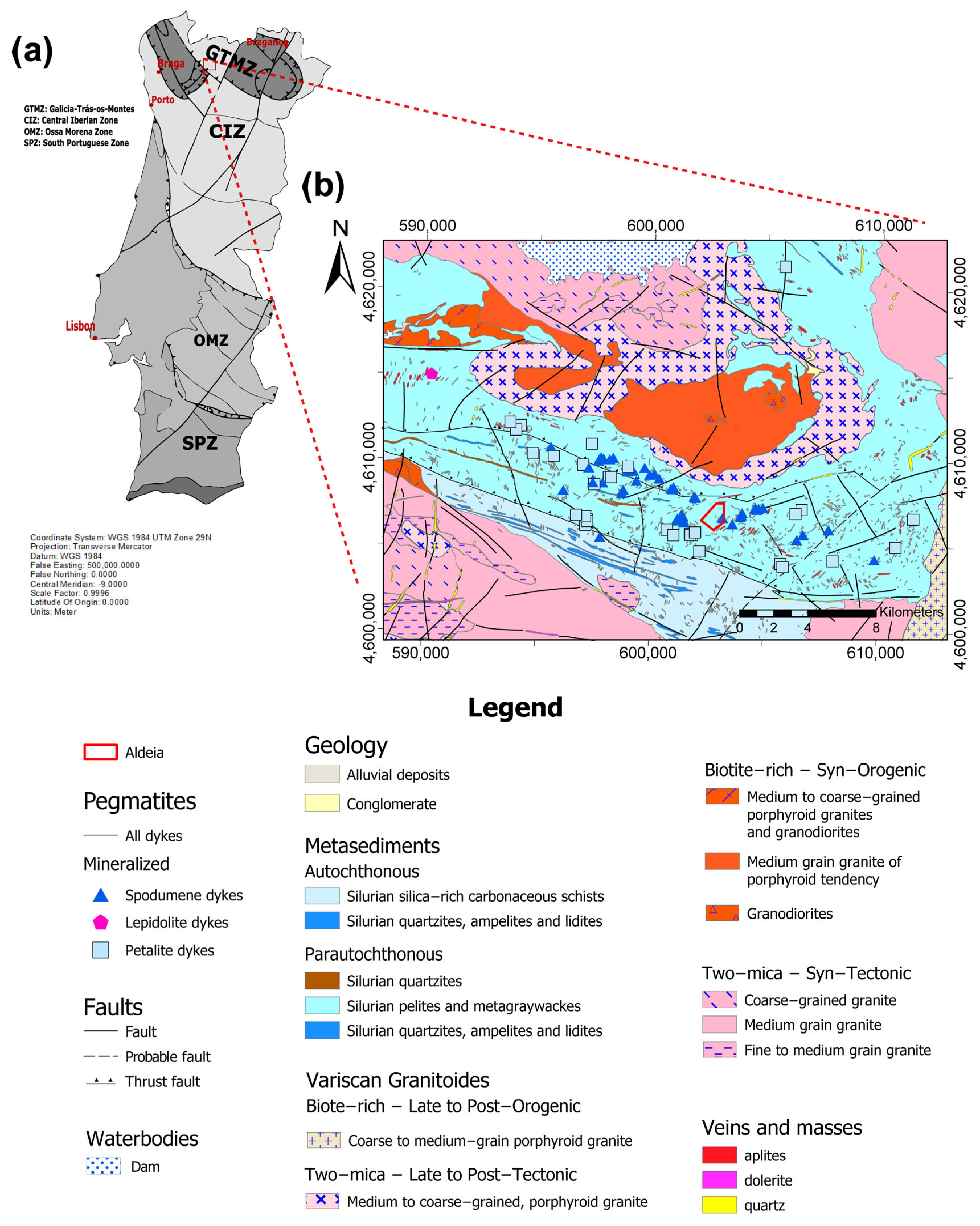
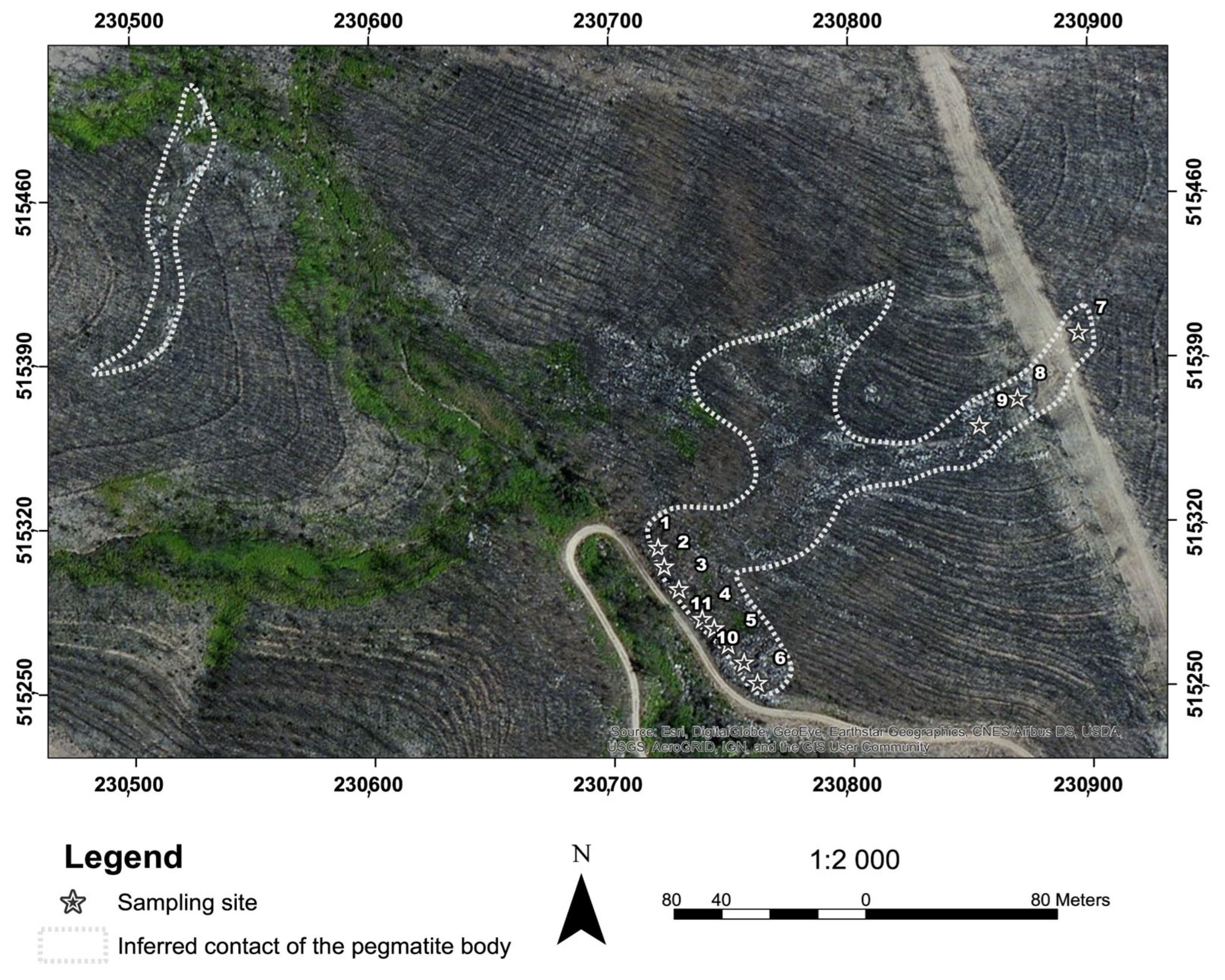

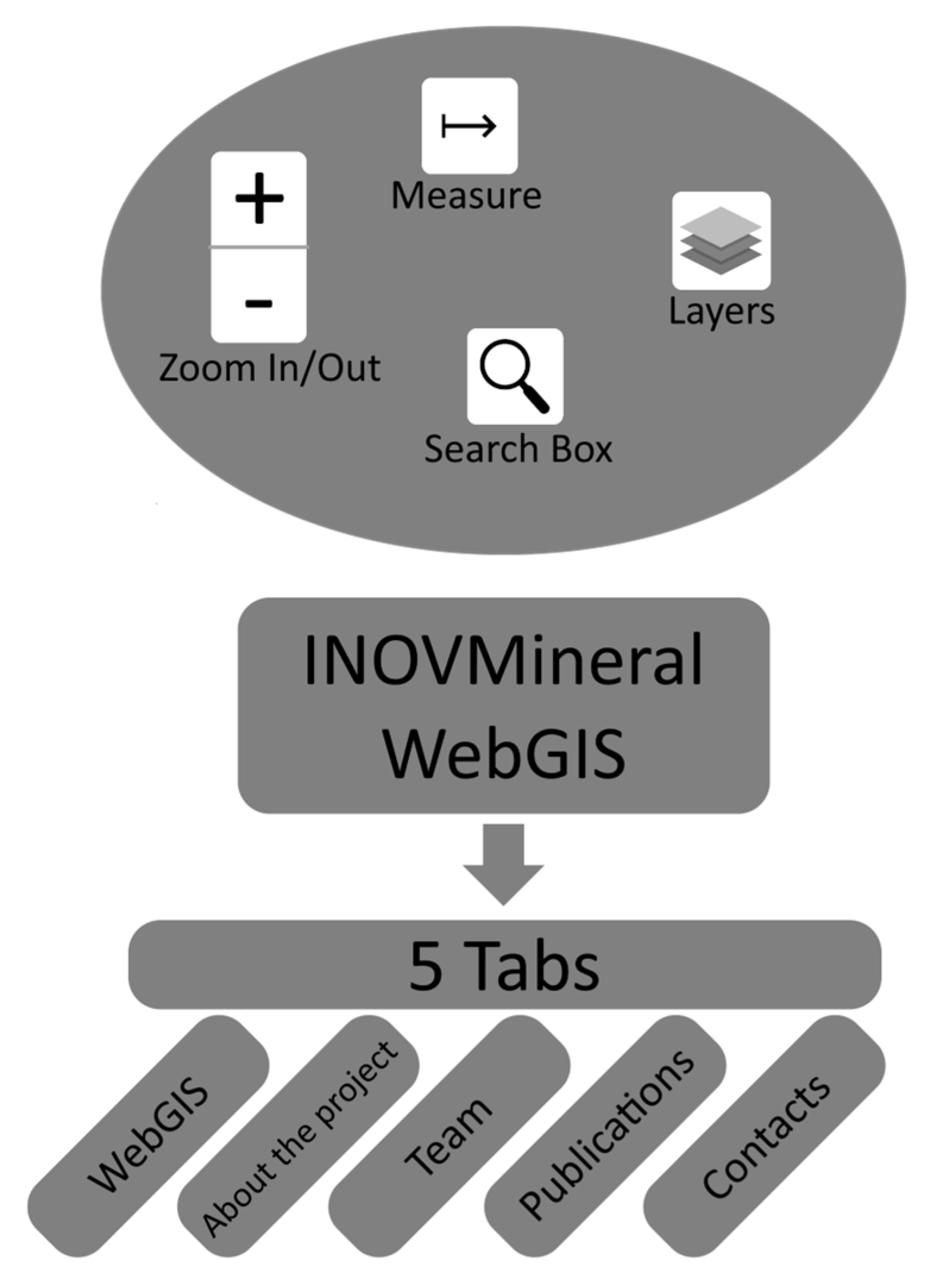
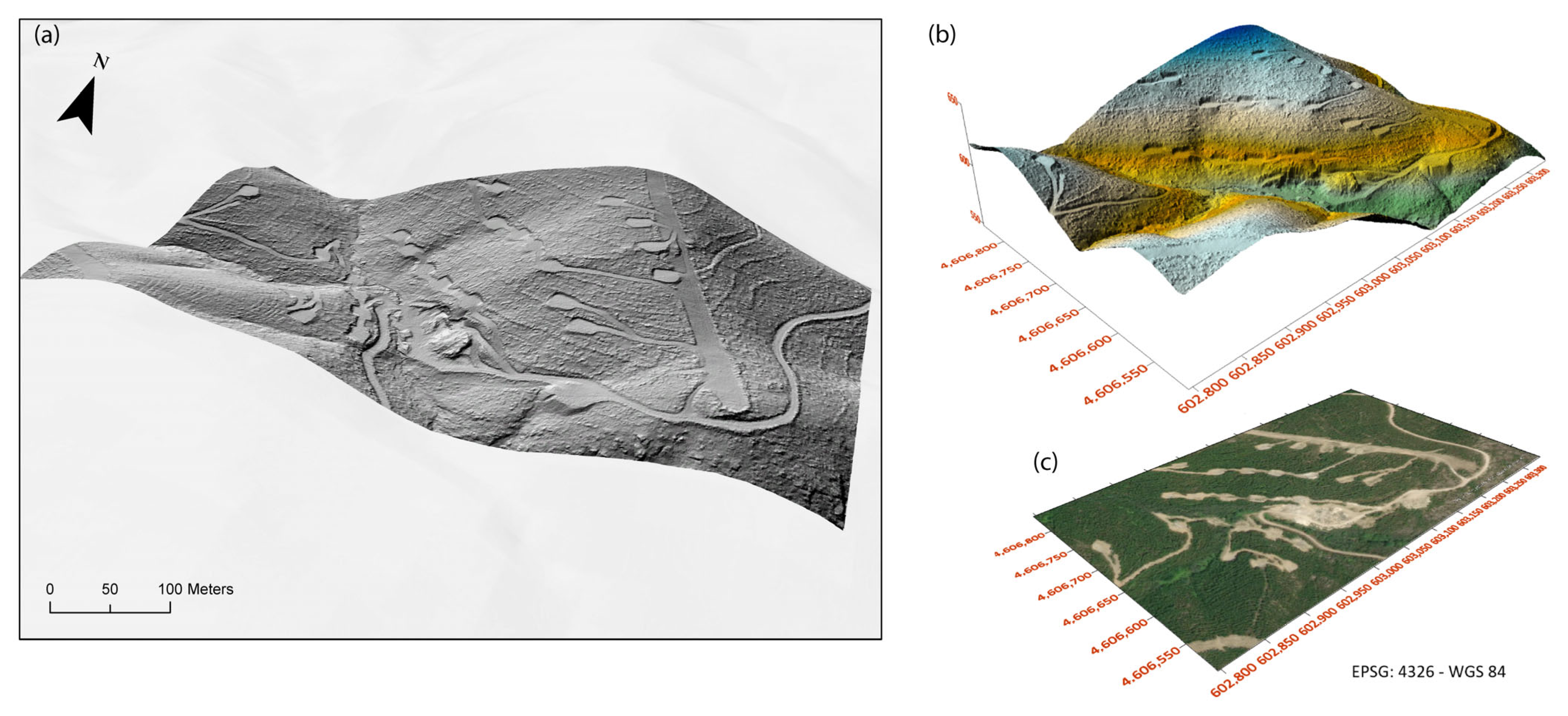
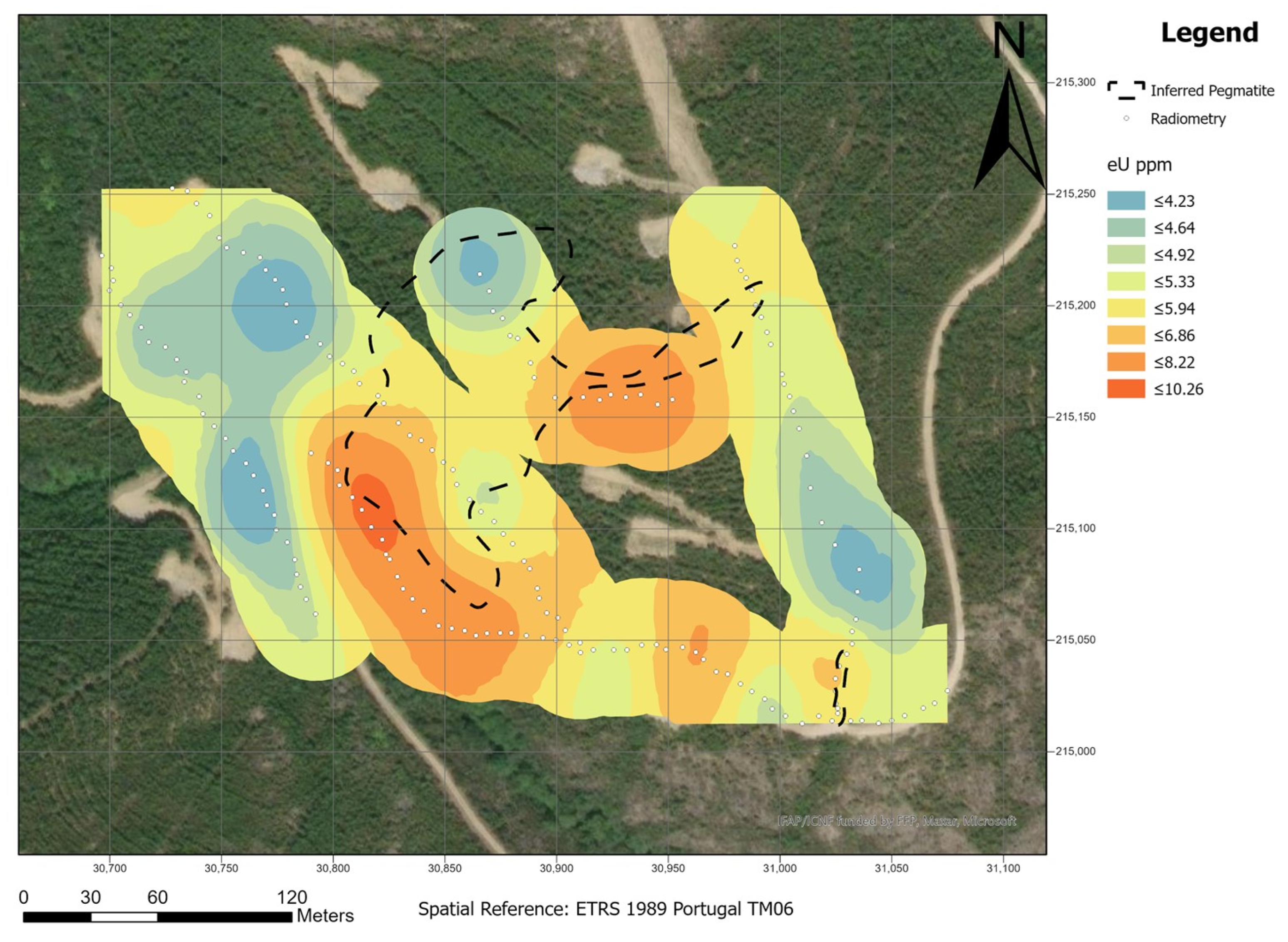
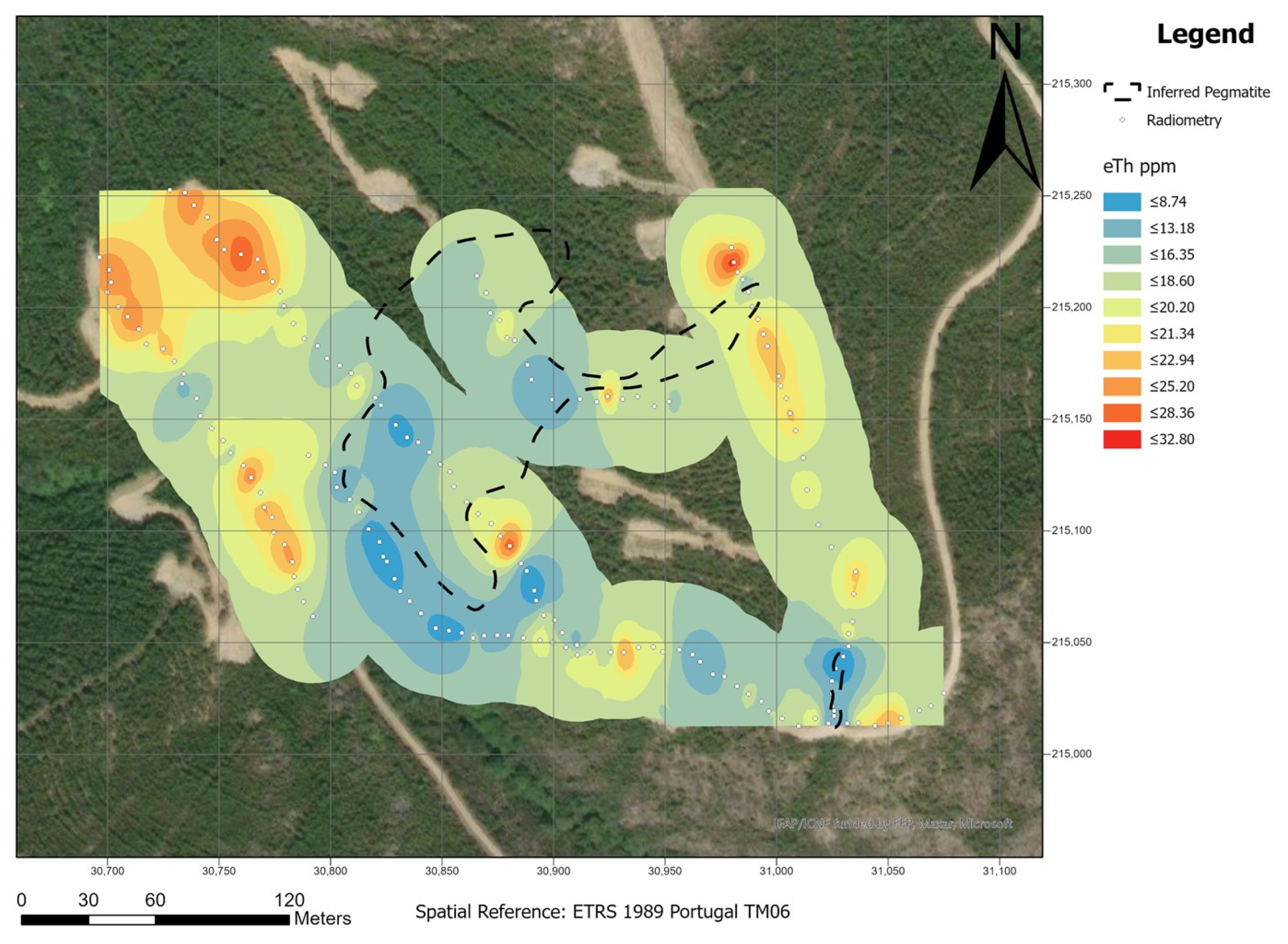
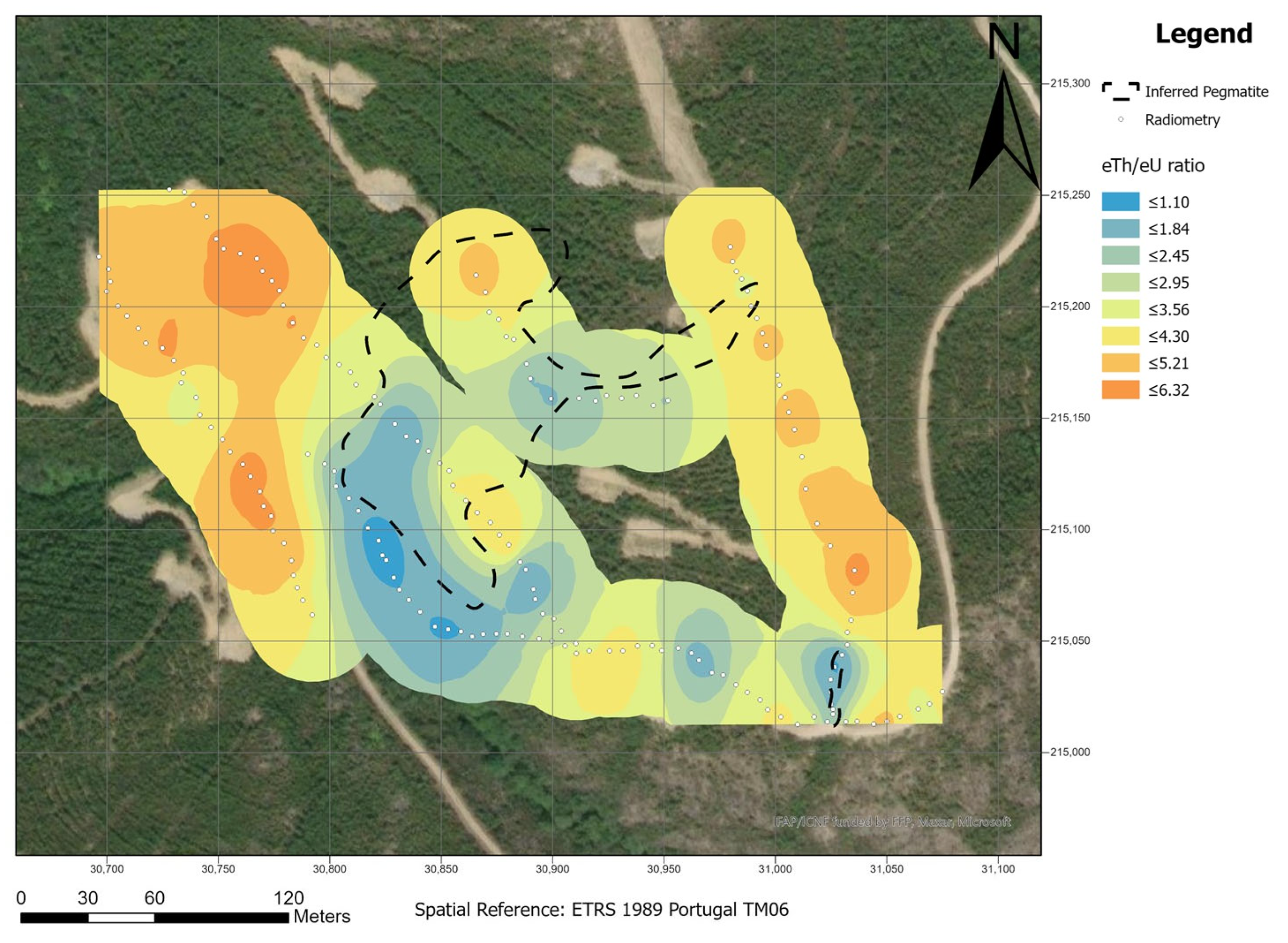
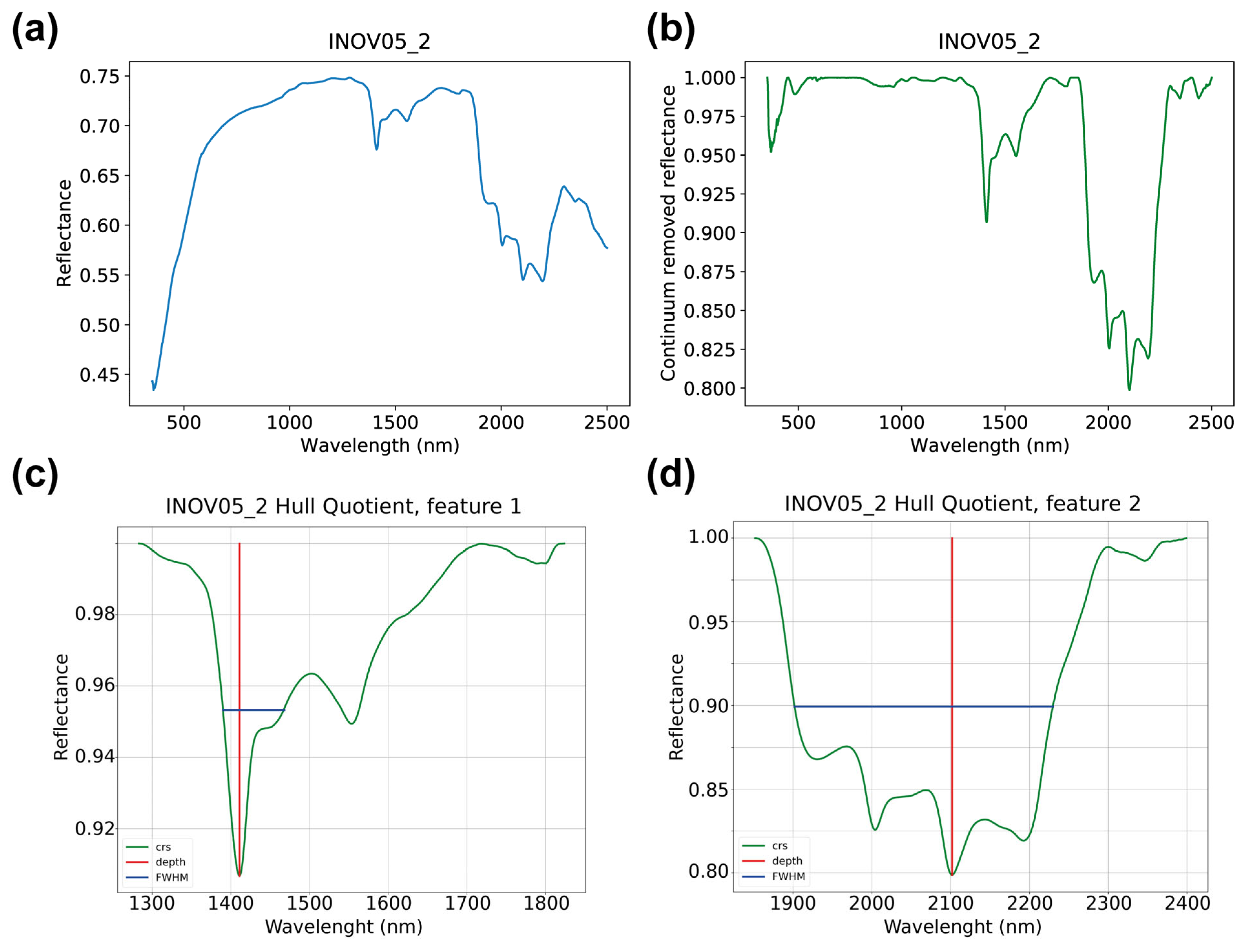
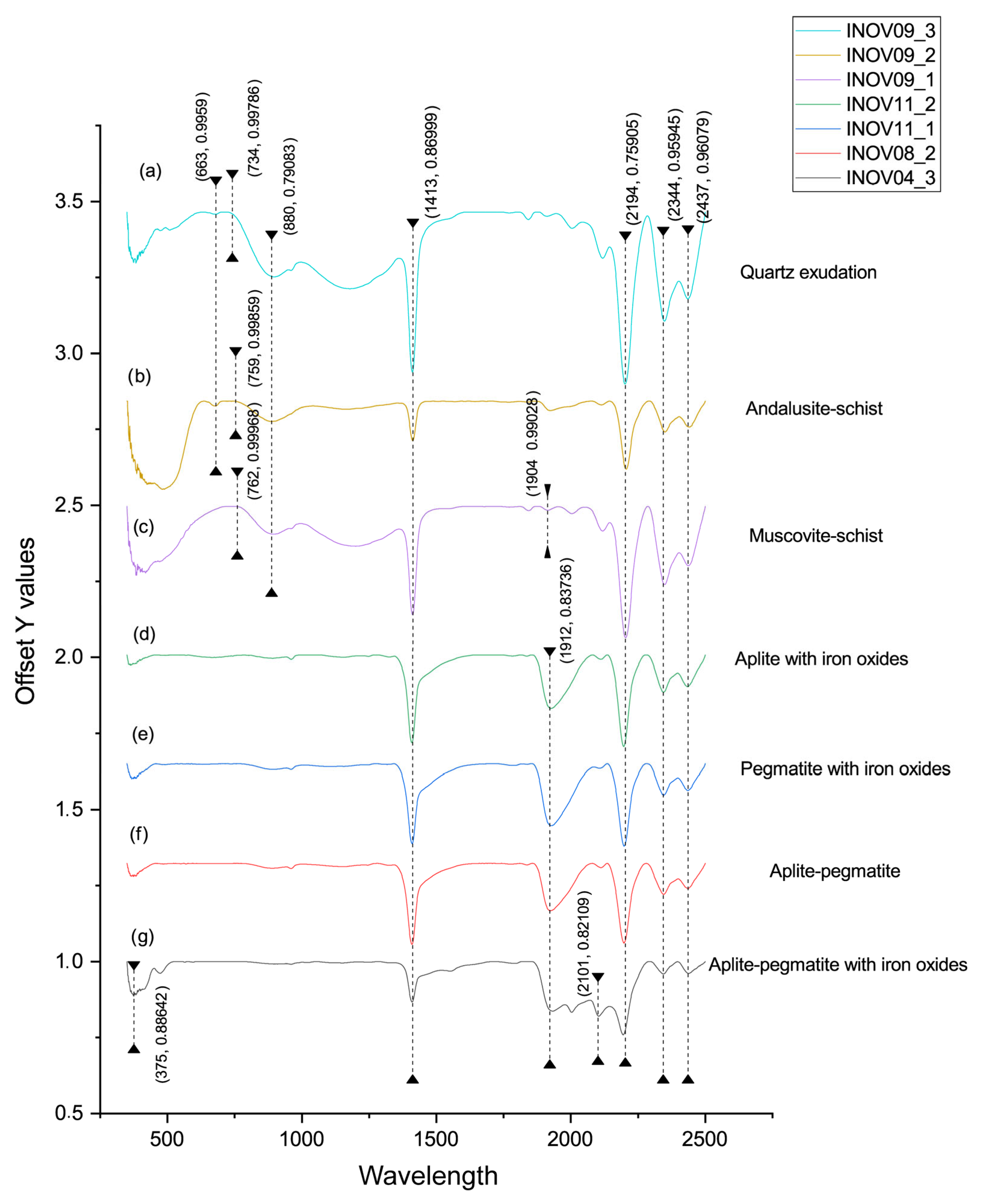
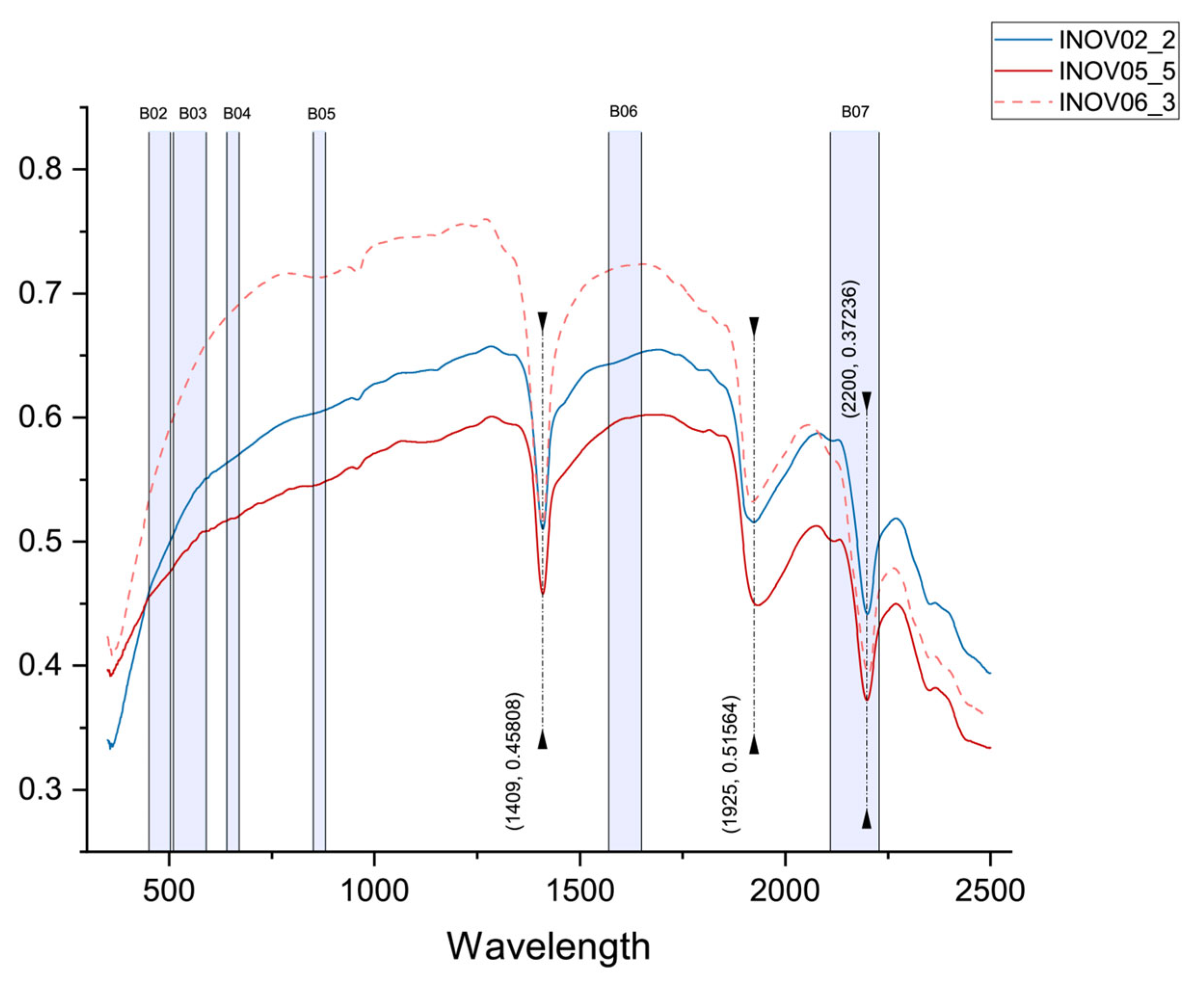

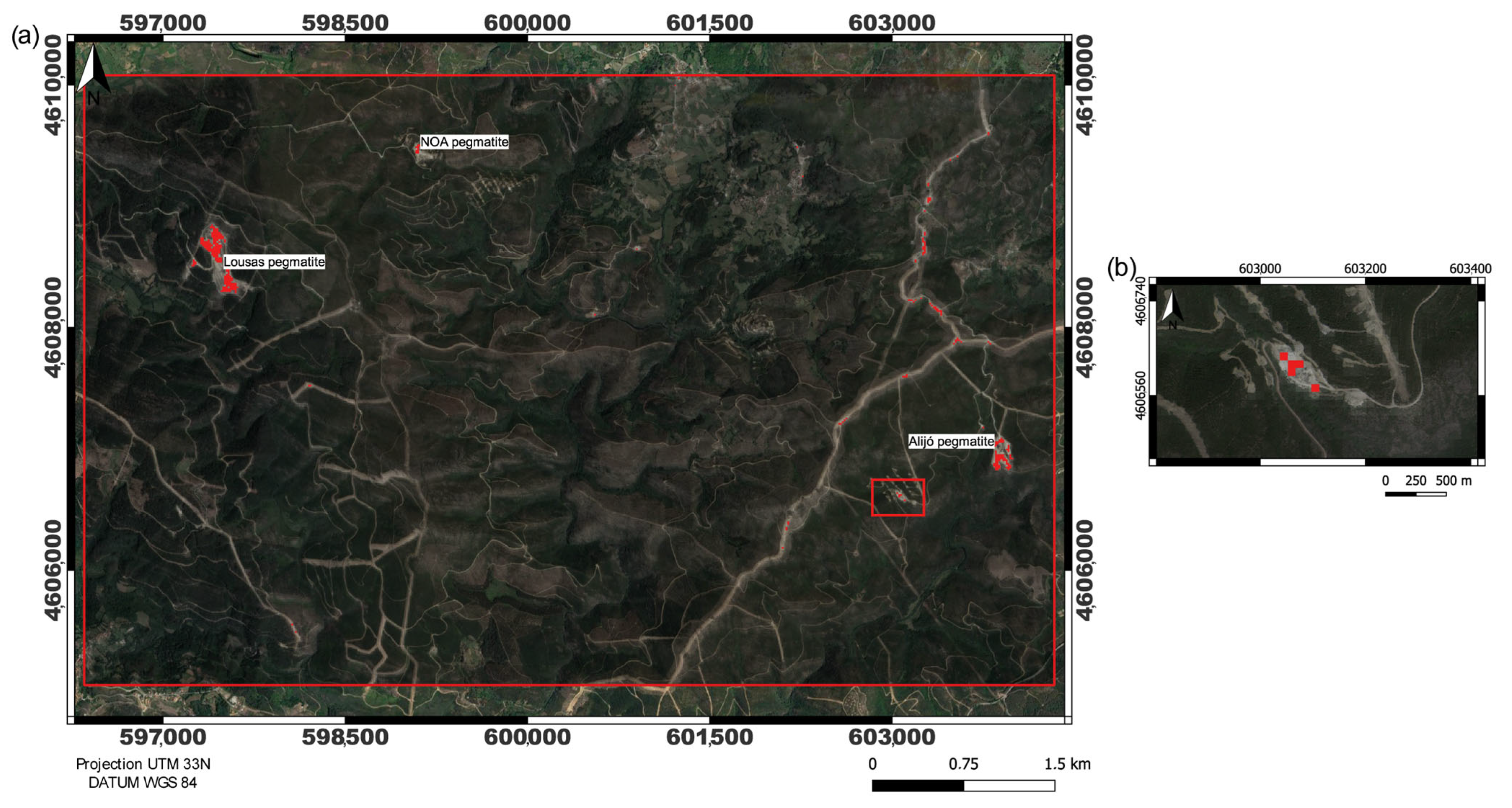
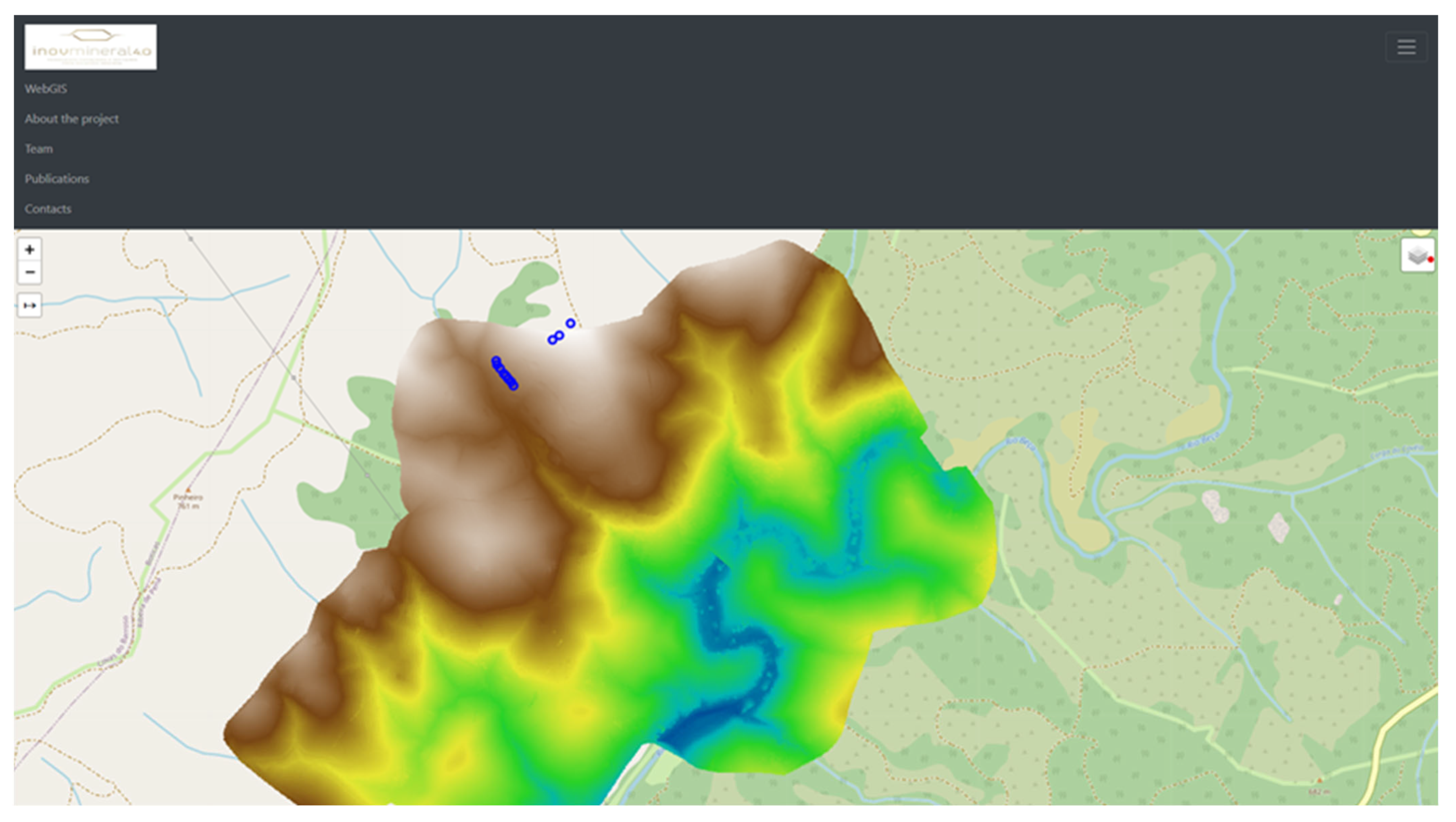

| Parameter | Landsat 7 (ETM+) | Landsat 8 (OLI) | Landsat 9 (OLI 2) |
|---|---|---|---|
| Radiometric resolution (bit) | 8 (256 shades) | 12 (4096 shades) | 14 (16,384 shades) |
| Temporal resolution (day) | 16 | 16 * | 16 * |
| Spatial resolution (m) | 30 (VNIR) 60 (TIR) 15 (Panchromatic-PAN) | 30 (VNIR) 100 (TIR) 15 (PAN) | 30 (VNIR) 100 (TIR) 15 (PAN) |
| Number of bands | 8 | 11 | 11 |
| Landsat 8 | Landsat 9 | |
|---|---|---|
| Date acquired | 2018/08/21 | 2022/01/28 |
| Land cloud cover | 0.03% | 3.23% |
| Data type | OLI_TIRS_L1TP | OLI_TIRS_L1TP |
| Product map projection | UTM | UTM |
| DATUM | WGS84 Zone 29 N | WGS84 Zone 29 N |
| Field Name | Description |
|---|---|
| ID | Primary key generated from Access software. |
| Sample_nr | Identification of the sample, represented by numbers from 1 to 11, for example: “INOV01”, (...), “INOV11”. |
| Spectrum_nr | Spectrum identification. The number indicated after the “_” represents the spectrum measured in each sample, for example, in sample “INOV01” four spectra were obtained, represented by “INOV01_1”, (...), and “INOV01_4”. |
| Locality | Place where the sample was obtained. |
| Sample_description | Geological description of the sample, considering visual aspects. |
| WGS84_Zone | UTM zone where the sample was extracted. |
| Latitude | Coordinate WGS84, where the sample was extracted (latitude). |
| Longitude | Coordinate WGS84, where the sample was extracted (longitude). |
| Preparation | Indication of the sample preparation routine. |
| Analysis | Equipment that was used in the spectrum collection. |
| Stored | Localization of the laboratory where the collection was carried out and where the samples are kept. |
| Face_color | Surface staining of the sample (visual observation). |
| Face_type | Type of sample face (visual observation). Ex.: exposed and sawn. |
| Photo | Photo indicating the area of the sample where the spectrum was collected (.jpg). |
| Raw_spectra | Raw spectrum collected (.txt and .pdf). |
| Processed_spectra | Processed spectrum, with removed continuum (.txt and .pdf). |
| Spectra_absorptions | Main absorption features automatically extracted (.png). |
| Spectral_mineralogy | Description of the sample considering the spectrally active minerals/compounds identified. |
| Sample Description | Number of Spectra | % of Spectra |
|---|---|---|
| Aplite–pegmatite with muscovite, plagioclase, and quartz | 28 | 59.57 |
| Aplite–pegmatite with muscovite, plagioclase, quartz, and iron oxides | 9 | 19.15 |
| Aplite with plagioclase, quartz, spodumene, and iron oxides | 5 | 10.64 |
| Muscovite-schist | 2 | 4.26 |
| Andalusite-schist | 1 | 2.13 |
| Exudation quartz | 1 | 2.13 |
| Pegmatite with iron oxides | 1 | 2.13 |
| LC08 | LC09 | Variance (%) | ||||
|---|---|---|---|---|---|---|
| PC | Band 6 | Band 7 | Band 6 | Band 7 | LC08 | LC09 |
| PC 1 | −0.806750 | 0.590892 | −0.835940 | 0.548820 | 98.38 | 99.25 |
| PC 2 | −0.590892 | −0.8067501 | −0.548820 | −0.835940 | 1.61 | 0.75 |
| LC08 | LC09 | Variance (%) | ||||
|---|---|---|---|---|---|---|
| PC | Band 3 | Band 7 | Band 3 | Band 7 | LC08 | LC09 |
| PC 1 | 0.278870 | −0.96032 | 0.278979 | −0.960297 | 98.27 | 98.80 |
| PC 2 | 0.960328 | 0.278870 | 0.960297 | 0.278979 | 1.72 | 1.20 |
| LC08 | LC09 | Variance (%) | ||||
|---|---|---|---|---|---|---|
| PC | Band 4 | Band 7 | Band 4 | Band 7 | LC08 | LC09 |
| PC 1 | 0.434049 | −0.900889 | 0.398671 | −0.917093 | 97.73 | 98.45 |
| PC 2 | 0.900889 | 0.434049 | 0.917093 | 0.3986717 | 2.27 | 1.55 |
Disclaimer/Publisher’s Note: The statements, opinions and data contained in all publications are solely those of the individual author(s) and contributor(s) and not of MDPI and/or the editor(s). MDPI and/or the editor(s) disclaim responsibility for any injury to people or property resulting from any ideas, methods, instructions or products referred to in the content. |
© 2023 by the authors. Licensee MDPI, Basel, Switzerland. This article is an open access article distributed under the terms and conditions of the Creative Commons Attribution (CC BY) license (https://creativecommons.org/licenses/by/4.0/).
Share and Cite
Cardoso-Fernandes, J.; Santos, D.; Almeida, C.R.d.; Vasques, J.T.; Mendes, A.; Ribeiro, R.; Azzalini, A.; Duarte, L.; Moura, R.; Lima, A.; et al. The INOVMineral Project’s Contribution to Mineral Exploration—A WebGIS Integration and Visualization of Spectral and Geophysical Properties of the Aldeia LCT Pegmatite Spodumene Deposit. Minerals 2023, 13, 961. https://doi.org/10.3390/min13070961
Cardoso-Fernandes J, Santos D, Almeida CRd, Vasques JT, Mendes A, Ribeiro R, Azzalini A, Duarte L, Moura R, Lima A, et al. The INOVMineral Project’s Contribution to Mineral Exploration—A WebGIS Integration and Visualization of Spectral and Geophysical Properties of the Aldeia LCT Pegmatite Spodumene Deposit. Minerals. 2023; 13(7):961. https://doi.org/10.3390/min13070961
Chicago/Turabian StyleCardoso-Fernandes, Joana, Douglas Santos, Cátia Rodrigues de Almeida, Julia Tucker Vasques, Ariane Mendes, Ricardo Ribeiro, Antonio Azzalini, Lia Duarte, Rui Moura, Alexandre Lima, and et al. 2023. "The INOVMineral Project’s Contribution to Mineral Exploration—A WebGIS Integration and Visualization of Spectral and Geophysical Properties of the Aldeia LCT Pegmatite Spodumene Deposit" Minerals 13, no. 7: 961. https://doi.org/10.3390/min13070961
APA StyleCardoso-Fernandes, J., Santos, D., Almeida, C. R. d., Vasques, J. T., Mendes, A., Ribeiro, R., Azzalini, A., Duarte, L., Moura, R., Lima, A., & Teodoro, A. C. (2023). The INOVMineral Project’s Contribution to Mineral Exploration—A WebGIS Integration and Visualization of Spectral and Geophysical Properties of the Aldeia LCT Pegmatite Spodumene Deposit. Minerals, 13(7), 961. https://doi.org/10.3390/min13070961











